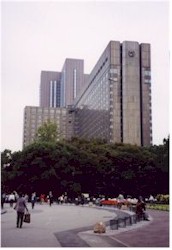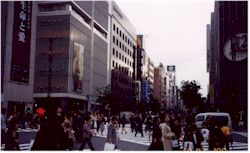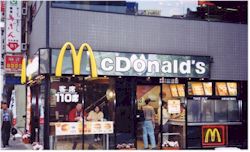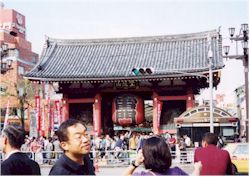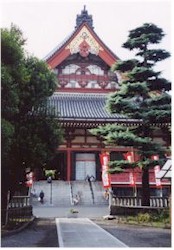| Tokyo[links] |
October 15 - October 21, 2000 |
||
Tokyo is a huge city, to the tune of 12 million residents. Yikes! The size of the city is impressive, not just in land area, but in the height of the downtown areas. Walking around makes a person feel small. Fortunately, I was taller than the average person, so that offset the feeling. We cannot say enough about the hospitality and friendliness of the Japanese people. It seems like every time we took out a map, somebody stopped to ask if we needed help. The language barrier was interesting, however, as one man stopped to ask if we needed any help, but it came out "What's the matter with you?" Thanks anyway! Our Hotel was incredibly nice. The Imperial Hotel is perhaps the most famous in all of Japan, and well deserving of it. The bilingual staff was most helpful...almost overly helpful, in fact. Here's Elaine's retelling:
We ventured over to the nearby Imperial Palace, which is a very beautiful place. The gardens surrounding it are spectacular, and the palace area is very impressive. Of course, one can't get very close to the palace. Security is a major issue. I was wishing we'd have been there during one of the few times during the year that the emperor comes out to make public addresses. That would have been neat. We got a true Tokyo dining experience when Koike-san (my Intel Japan contact) took us out for dinner at a quaint little basement restaurant. As soon as we set foot in the door, the call "Irasshaimase!" (Welcome!) rang out from front to back, being repeated by all the serving staff of the establishment. Here's Elaine's account of the meal:
One thing I should add is that as we pointed to items on the menu, Koike-san would tell us what they were. One thing we didn't try was chicken skin on a skewer. We also pointed to something we thought was skewered beef, but Koike-san said "most Westerners do not rike this." We decided not to ask what it actually was, and elected not to order it. Call us wimps. One of the puzzles of Japan was the plastic food. Outside nearly every restaurant were displays of plastic food, showing what fare was available, and naming some prices. Udon noodles were one of my favorite foods, but there is possible nothing more disgusting than the plastic models of Udon in broth. It looks like head cheese with white worms in it. Ick! We didn't want to settle for just seeing downtown Tokyo, so we decided
to visit the historical district of Asakusa ("ahsacksah").
We took a water bus, passing under twelve bridges, and showing a different
side of Tokyo. The apartment buildings are pretty amazing, and we
saw some truly spectacular graffiti along the river. After arriving
at Asakusa, it wasn't long until we came to a very large red gate, called
the Kaminarimon Gate. Here's Elaine's account of our adventures in Asakusa. Here's a recommendation concerning visiting temples. Elaine and I stopped for Sukiyaki before heading to the temple. This was a mistake. Of course, I recommend the Sukiyaki/Shabu-shabu dining experience for any Westerner...it's great stuff! But, most of the temples we went to had streets lines with shops and food tents leading up to them. When we got to Sensoji Temple, there was a tent serving loads of Yakisoba, but we were already full, so we missed out on it. Do yourself a favor, check what's available before jumping into anything. It was unfortunate that we didn't have the luggage space to collect LOTS of trinkets. Actually, it was probably VERY fortunate that we didn't. Another recommendation here, go to the Oriental Bazaar in Tokyo. One stop shopping for souvenirs!!! More on that on our Leaving Japan page. One other thing we noticed was the proliferation of Italian restaurants in Tokyo. We went to three during our Tokyo stay, all of them very good. One was "La Boheme", which is a neat place in a basement. You sit at tables in a seating area in a "u" shape around the open kitchen. The food is excellent, and I doubt you'll find some of the selections at an Italian place anywhere but Tokyo. Here's Elaine's synopsis:
The last place we went for dinner was called "Kushi Colza", and it's a place that any American Tourist should visit. It's a small establishment, with only a few tables and a bar, but the food is very good. They serve Yakitori and Kushiyaki, which basically means skewered everything. Don't believe me? Elaine had skewered ice cream. Hehehe. The place is owned by the Kikkoman soy sauce company, so guests get a complimentary soy sauce to take home. We still haven't used ours, but it's in a neat year 2000 container. Tokyo is an amazing city...one could spend a couple of weeks exploring it, but we had a long list of places to visit, so we didn't dawdle. Instead, we moved on... Rolling on...to Kyoto..... Tokyo Links: [ Main Page ] |
|||
|
The Imperial Hotel was originally built in 1922, designed by Frank Lloyd Wright, but in its present form dates from 1970, and includes a 31-story tower. If you have the means, I highly recommend staying there. But I will warn you that our five night stay there cost more than Elaine's round-trip ticket. Fortunately, the company was picking up the tab. |
|||
|
The Imperial Palace is the official residence of Emperor Akihito, the 125th emperor of Japan. The palace was rebuilt in 1968 after being destroyed by bombing during WWII. This is about the best view one can get of the palace. The Emperor is a private sort. |
|||
|
It may be difficult to see, but this is a six-way crosswalk. The streets absolutely teem with people, particulary at lunch hour! |
|||
|
McDonald's turned out to be a relatively cheap place to find pancakes. Oh, sorry, the "HotoKeekesu Setto" (that's how the Japanese translates). Look hard and you can see Mark and Seth in there. |
|||
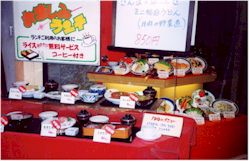
Ahh...plastic food. Makes me hungry just looking at it....ugh. Nothing, but nothing, looks appetizing in plastic. |
|||
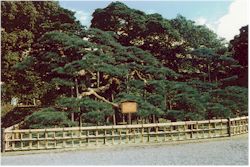
On our way to Asakusa, we walked through a park and found this 400 year old pine. The larger image shows better the many supports under all the huge branches. |
|||
|
The Kamarinon gate, the beginning of the walking tour to Sensoji Temple. The paper lantern you see weighs 250 lbs. That's a BIG paper lantern. |
|||
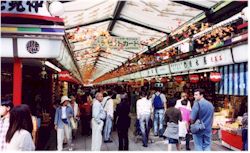
Nakamise Dori (dori="street"), a covered walkway lined with hundreds of shops. One can buy anything from sweets to swords to postcards to kimonos here. Quite an experience! |
|||
|
Sensoji Temple, the main attraction of Asakusa. If I ever get that last roll of film developed, I think I have some good ones of the ceiling in there. |
|||
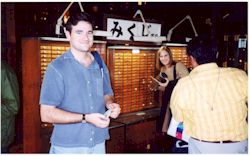
Seth with his newly aqcuired fortune: "When spring comes, all trees and grasses are in full bloom. Everything will go good, then you will be happier in future. When you get the archery of the big warrior general, your happiness it reassure, wealth will grow large such as to have to carry by coach." I won't even ask what the archery of the big warrior general is. |
|||
